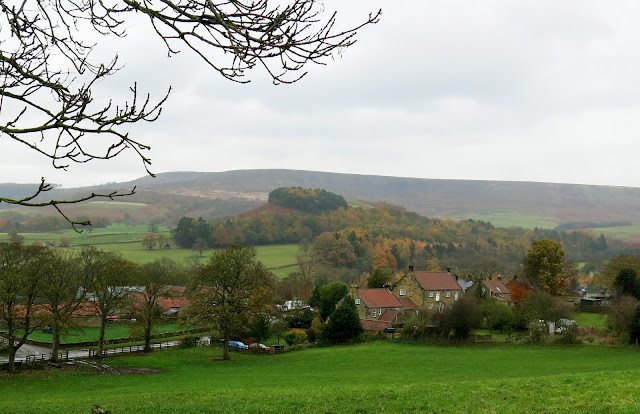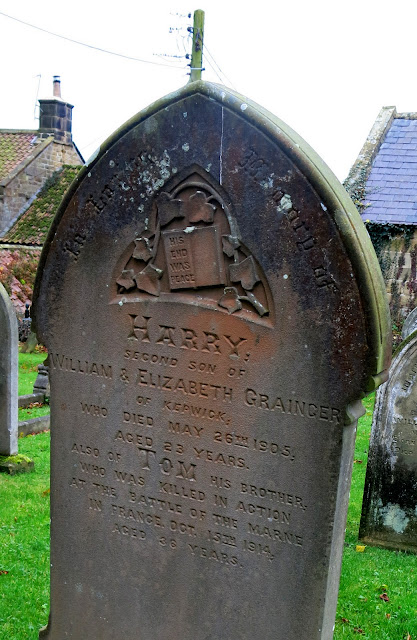Kepwick and Cowesby from Over Silton
5 miles Cold and grey
We decided to do a shorter walk today as the forecast had been so threatening. In the end we had one short shower which should teach us to pay no attention to weather forecasts.
We parked at Over Silton at the roadside opposite the Old School House, having approached the village from the A19.
 |
| Today's walk from The Walker's Guide to the Hambleton Hills |
 |
| The Old School House |
Tom Scott Burns notes that the name Silton probably derives from Sal as in Upsal, which means Hall and Ton which is old Anglian for place or town.
We followed the road out of Silton and turned into a field at a gate. There was no way-mark and most of the early part of this route shows no indication of having being walked, so is little used.
 |
| The road out of Silton |
 |
| Leave the road at the gate |
We walked through fields until we reached Greystone Farm, passing by the attractive and tidily kept buildings to see a small open barn full of rosettes and prize certificates.
 |
| Plenty of First Prizes! |
 |
| Prize winning Suffolk Sheep |
We continued along field paths until we reached Nether Silton where we were pleased to spot a new (to us) weather vane. We crossed the road and and rejoined our path which led us to Hall Farm.
 |
| Weather vane at Nether Silton |
 |
| Green at Nether Silton |
 |
| Approaching Hall Farm |
We continued beyond the farm to walk through sodden fields until we reached the footbridge over Sorrow Beck. We passed two gates that had three different fastenings on each. Untying them was awkward and it was apparent that no-one had been this way for a while.
 |
| This gate had so many ties on it that it was apparent that walkers are not using this route |
 |
| Walking beyond Hall Farm.... |
 |
| ... to reach Sorrow Beck |
 |
| Sorrow Beck |
After crossing the beck we walked through fields to reach a stone footbridge which was built over what used to be a 3.5 mile narrow gauge railway. Constructed in 1833 this railway brought limestone mined near Kepwick to kilns near to the Yarm and Thirsk turnpike road. We crossed another field and joined Peasland Lane which we followed for a mile into Cowesby.
 |
| Old railway bridge |
 |
| Our first glimpse of St Michael and All Angels Church |
 |
| The entrance to the old church |
 |
| St Michael and new tower roof |
The first building we came to on entering Cowesby was St Michael and All Angels Church whose porch provided a shelter to enjoy our coffee and scones. We noticed that the church was sporting a new slate roof on its tower since our last visit. The door was unlocked and we spent a few moments exploring the old building before resuming our walk through the village.
 |
| Weather vane at St Michael's |
 |
| The interior, showing signs of damp |
 |
| Clive finds a mite for the collection box |
 |
| Ornate door at St Michael's |
 |
| Cowesby |
 |
| Weather vane at Cowesby |
 |
| The first way-marks seen on this walk |
We walked through Cowesby, past Home
Farm, then followed a path bearing left along the western shoulder of Pen
Hill. This path then led us down towards Kepwick. TSB mentions that a
John Henry Warner constructed two reservoirs on the moors above Kepwick
in 1873 to supply water to Kepwick Hall and we came to an old stone
building with the remains of a large metal pipe in its floor. We
guessed this must be something to do with Warner's reservoir system.
 |
| Old quarry workings at Pen Hill |
 |
| A sudden shower |
 |
| Kepwick from Atlay Bank |
 |
| Old pumping house |
We didn't enter Kepwick but crossed straight over the road and over a stile into a field that contained cows and a large brown bull, but fortunately they showed little interest in us.
 |
| Cross the road at Kepwick and straight into fields... |
 |
| ... of cattle |
We crossed the remains of the old railway line once more, and made our way to Bridge Beck where we found the bridge to be in an even worst state than when we last passed by.
 |
| The old railway line |
 |
| Across muddy fields to Bridge Beck |
 |
| Unsafe bridge at Bridge Beck |
A short walk through trees brought us once again to Sorrow Beck whose bridge was in a better state, then into fields which we crossed to reach Nether Silton.
 |
| Better bridge at Sorrow Beck |
 |
| Clive shied at this jump and walked round it |
There is no path across these fields and way-marks are few and far between, but head for the old Manor Stone which is in the middle of a field next to the manor house which dates from the 16th century. The stone is cryptically inscribed with letters whose meaning I've set out below the photograph. This inscription was the idea of a Squire Hicks to mark the spot where the medieval manor house once stood.
 |
| The old Manor Stone at Nether Silton |
 |
Here The Grand Old Manor House Stood
The Black Beams Were Oak, The Great Walls Were Good
The Walls At The East Wing Are Hidden Here
A Thatched Cottage Like A Barn Was Erected
Year AD 1765
A Wide Porch Spans A Yard And Alcove
|
 |
| The old manor house |
Near to the manor house is the chapel of ease of All Saints which was rebuilt in 1812. Such a chapel is built for the convenience of parishioners who find it difficult to access the main church, in this case isolated St Mary's. We found it unlocked and went inside.
Tom Scott Burns explains that wood used in the altar rails and other
refurbishments were presented by a R M Jaques, and were from HMS
Dreadnought of Lord Nelson's day. This chapel was in far better repair
than the church at Cowesby.
 |
| All Saints, Nether Silton |
 |
| Headstone at All Saints |
 |
| Looking towards the altar windows |
 |
| Altar window |
 |
| Clive up in the 'Gods' |
We were interested to see a memorial to
the fallen from WWI listing seven men from this tiny hamlet, and
in the graveyard saw a memorial to one of them, a soldier who fell at
the Battle of Marne.
 |
| Died at the Battle of Marne |
 |
| Our home is sad and lonely now, since one we loved so well is gone, the bitter tears of grief do flow, as dreary hours roll slowly on |
 |
| His languishing head is at rest, his thinkings and achings are o'er, his quiet immovable breast, will heave by affliction no more |
After wandering round the graveyard and reading some of the cheering Victorian epitaphs we left the church and immediately turned off the road at a white gate opposite, just near to the post box.
There is no sign to indicate this public path, which leads through to fields. Once in the fields we were now returning and parallel to Greystone Farm and its Suffolk sheep.
 |
| Turn left at the white gate... |
 |
| .... into a little path... |
 |
| ... to fields |
After crossing the tarmac of Kirk Ings Lane we reached St Mary's
Church, which appears abandoned in the middle of a field, positioned some
distance
from the village of Over Silton.
 |
| Cross Kirk Ings Lane.... |
 |
| .... and the field to isolated St Mary's |
We felt we had 'done' enough churches for
today's walk so we passed it by and crossed the field to the road
leading us back into Over Silton
and our car.
 |
| Crossing the field to Over Silton |
 |
| We get a noisy welcome at Over Silton |
